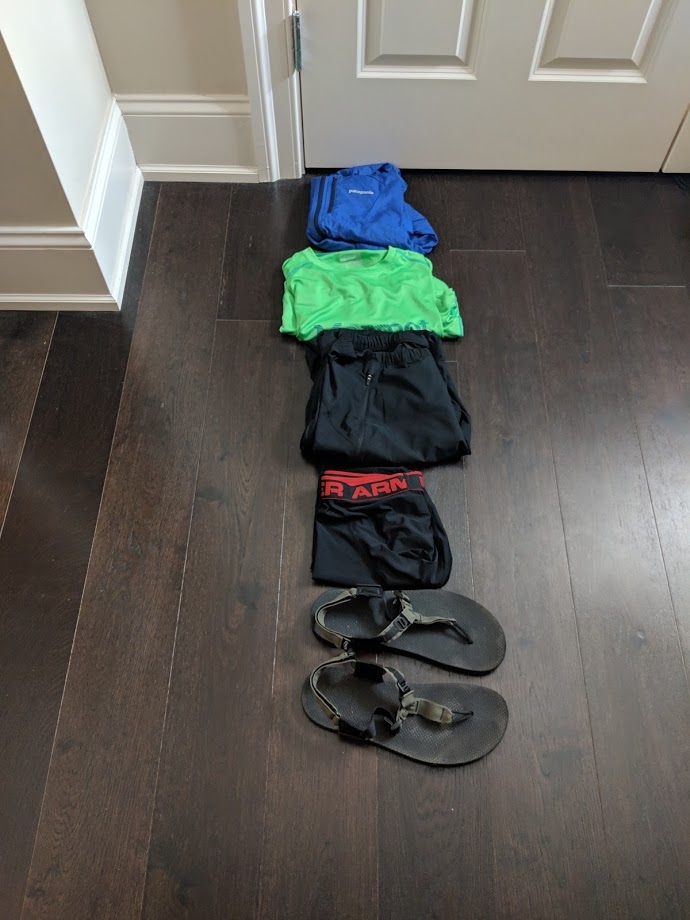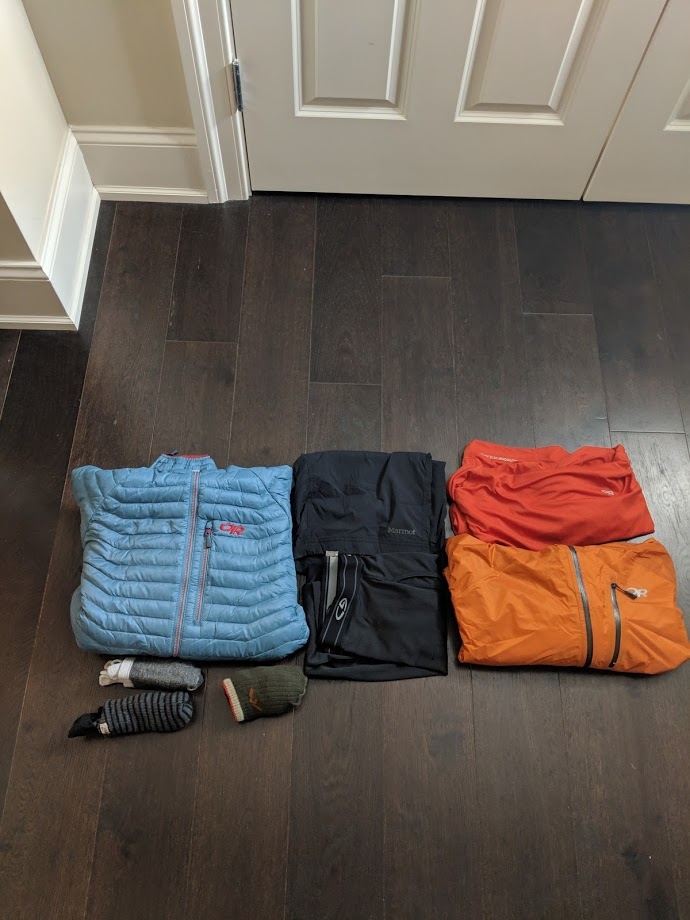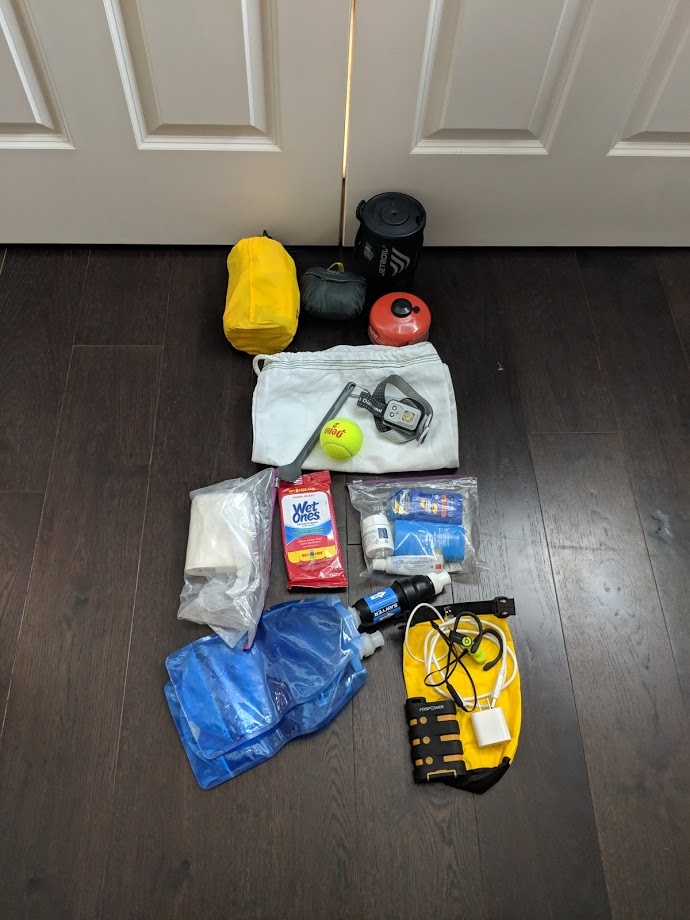My Life Packed into 14 Pounds – AT NOBO Gear List
Over the last year I have slowly been fine-tuning and testing my gear, trading in older heavier stuff for newer, more durable and lighter equipment (thank you, REI garage and Black Friday sales). There has been painstaking, almost exhausting research, reading reviews, updating spreadsheets, and plenty of chatting with other hikers and the awesome staff at a few outfitters. While I am not planning on going into this hike ultralight (UL), that does not mean I am not weight conscious and focused on being lightweight. I have managed to cut several pounds off my original base weight and started looking at where I could shave some more ounces, but too much of that game just isn’t for me. After a final few adjustments I am happy and comfortable with the 14-pound setup that I have.
There are a few items I am starting with that I know will get swapped out once consistently warmer weather sticks around, like sleeping bag, long-sleeved shirts for T-shirts, and dropping a spare base layer for sleeping. As for the other items, shakedown hikes have been incredibly helpful in guiding my decisions as to what will be coming and what won’t. However, a few day shakedown hike and a thru-hike are entirely different animals, and despite me being happy with and loyal to my gear, if something isn’t working, it isn’t working and I am OK with making changes as I go.
So naturally, this begs the question of, “David, what exactly are you carrying in your backpack for your thru-hike?”
Well. I’m glad you asked!
Seriously. I am. As many prospective thru-hikers can relate, gear gets us excited and I love talking about it. So let’s take a dive down the gear rabbit hole and see what I am planning on starting with for my upcoming AT NOBO thru-hike.
The Big Three: Shelter, Sleep, and Pack
Sleep: Cold weather bag—Hyke and Byke Elous 15 Degree Down Bag. I plan on swapping this bag out for the Hyke and Byke Shavano 32 Degree Down Bag once I hit consistently warmer weather. Sleeping pad—Therm-a-Rest NeoAir Xlite. Pillow—Sea to Summit Aeros Pillow.
Shelter: Six Moon Designs Skyscape Trekker
Pack: Gossamer Gear Mariposa 60
Worn Clothing
Hiking clothes: Patagonia Houdini Jacket, Marmot Windridge Long Sleeve Shirt, Arc’Teryx Stradium Pant, Under Armor compression shorts.
As the weather warms up the Arc’Teryx pants will be swapped out and stuffed into my pack for a pair of Marmot- Zephyr Shorts. The pants will likely turn into something to wear while in town or on exceptionally shitty weather days.
Footwear: Bedrock Carin Sandals. Yes, I am planning on hiking in sandals. I have tried just about every type of trail runners out there and have yet to find one that is more comfortable than my Bedrocks. I have a pair of Brooks Cascadias that come in second place to my Bedrocks and I may end up starting with these depending on the weather conditions. With an April start, I am hopeful that if I do start in trail runners, it won’t be for long.
Packed Clothing
Jacket: Outdoor Research Verismo Hooded Down Jacket
Sleep/camp clothes: Marmot Zephyr Shorts, Champion Duofold Thermal Pants, Outdoor Research Echo Hoody and Darn Tough Micro Crew Socks
Rain jacket: Outdoor Research Helium II Rain Jacket
Socks: Injinji Sock Liner, Injinju Midweight Toe Sock. Yeah, that’s right, some days I like to rock the socks and sandals. #noshame
Cooking, Water, and Everything Else
Cooking and water: Jet Boil Zip Cooking System, Sea to Summit spork, Sawyer Squeeze water filter, pictured here with two 1L Platypus water bags, for my thru-hike I’ll be using two 1L Smartwater bottles.
Food storage: Ursack Major Bear Bag,
Everything else: Black Diamond Gear headlamp, trowel, toilet Paper, Wet Ones wipes, Advil, Body Glide, sunscreen stick, tennis ball for rolling out muscles and feet, O’Keeffes Healthy Feet—a must when hiking in sandals.
First aid/ survival kit: Band-Aids, gauze pads, Quick Clot, tourniquet, Leukotape, assorted OTC medications, fire starter, compass, waterproof matches.
Electronics: Sea to Summit 1L dry bag with portable charging block, wall charger adapter, USB cable for glucometer and charging block, USB-C cable for phone, Power Beats Earphones for podcasts and music.
Diabetes stuff: Not pictured is 2L Sea to Summit dry bag that will have all of my diabetes stuff, which consists of two spare Dexcom CGM sensors, plus the sensors needed until my next resupply, two spare Omnipod pumps, plus the pods needed until my next resupply, insulin, glucagon and my glucometer.
This website contains affiliate links, which means The Trek may receive a percentage of any product or service you purchase using the links in the articles or advertisements. The buyer pays the same price as they would otherwise, and your purchase helps to support The Trek's ongoing goal to serve you quality backpacking advice and information. Thanks for your support!
To learn more, please visit the About This Site page.







Comments 10
Nice job going as light as possible. Too many, me included at first, go cheap instead of light and pay for it in the long run. However,I would loose most of your 1st aid kit. Baindaids don’t stick to sweaty skin for more than a few miles for example. Also the tennis ball, altho a good idea can be substituted with a round Rock found at most camp sites. You’ll prolly end up using it more for playing catch or other form of entertainment! Anyway, good luck!
Thanks!
My best to you. Will follow.
Awesome set up! I look forward to hearing about your trip.
Thanks!
Three suggestions and a request:
1) Use an OPsak plastic bag in conjunction with your Ursack; will keep all critters’ noses utterly innocent of the fact that you have food! You can buy at ursack.com.
2) Instead of Band-Aids, buy a roll of Leukotape. You have to buy a big roll, but what I do is wrap a couple yards of the stuff around toothbrush, pen, bottles, etc.
3) Bring some Vagisil; miracle cure for chafe.
And: I’m working on a story for The Trek about hiking in sandals. I’ve done some of that myself and am also interviewing others who have. Would you be willing to chat with me about your experiences hiking in sandals? If so, please email me at claybonnyman (at) gmail.
Thank you.
Thanks for the suggestions, I just ordered the opsak for the ursack!
Regarding hiking in sandals…. One needs to be careful about dry (cracking) skin. This can be extremely painful as cracks can run deep below the dermis line. (shortly after the pain sets in, infections often follow) Also, it only takes one stick stepped on by the fore foot to ruin a perfect day. This incident may raise a piece of wood into a position where damage can occur to the trailing toes. Chances are both of these misfortunes will occur over the duration of the hike. Be forewarned, and play it safe with running sneakers instead.
I did not endeavor to come across so harsh in my last post. In retrospect, the ability to hike long distances in sandals is due in part to the overall health of one’s body. What I am alluding to is age. Younger people are far more resilient to the effects of dry skin than their older counterparts.
Dry skin is caused by a lack of relative humidity in the immediate vicinity of the feet. If cracks start to occur, wearing socks in addition to the sandals for a few weeks will slowly start to heal them. The second hazard of ramming the trailing foot into a slightly raised stick does exist and will most likely happen when least expected. This has happened to me in the past and can really sting or even worse.
Running shoes (not trail runners) are very light weight and with proper ventilation (plethora of holes in the toe box) dry within hours of wet conditions.
Hiking in less (barefoot) can also be a wonderful way to gain a closer connection with the trail and the inner spirit. Oftentimes I have removed my shoes and socks for an hour or so during the day and experienced wonderful results. It can be nice to break up the routine when hiking so many days in row.
There will also be times when the temperatures are quite chilly to freezing and the extra warmth from sneakers can be welcomed.
With the pleasure of having so many days to enjoy oneself along the way, one may stroll along anyway they see fit. Flexibility and fun are the names of the game.
This post sends hope for you to have the most pleasant experiences along the way in 2019.
Good luck with the sandals.
No worries, didn’t come off as harsh. I appreciate all the feedback and suggestions from others. While I am all about hiking in sandals, I am not married to the idea. If the sandals aren’t working for me, I’ll switch to my trail runner’s, which I do like, just not as much as my sandals.
I’ve put about 500 miles on sandals and so far haven’t had any serious issues. I’ve been using O’Keeffes foot cream and socks as needed. So far this has kept and dry or cracked skin at bay.
As for the the open toes and heels, I’ve found that I take better and more deliberate steps when I’m wearing sandals. I have less rolling and twisting of my ankles and knees and also have less pain in my hips and knees are the end of the day.
With my planned later start date, I’m pretty confident that sandals will work well for me but if they don’t I’ll jump into my trail runner’s and keep on walking.